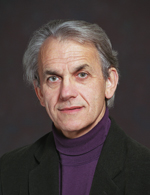Ted Norris named Gérard A. Mourou Professor of Electrical Engineering and Computer Science
In the tradition of our best faculty at Michigan, Ted is a phenomenal teacher and mentor as well as researcher. Congratulations!

 Enlarge
Enlarge
Ted Norris has been recognized for his outstanding contributions to science, technology, and education by being named the Gérard A. Mourou Professor of Electrical Engineering and Computer Science.
Prof. Norris was given the opportunity to select the name of his professorship – and he chose the name of his former advisor and world-renowned researcher Gérard Mourou (see more below).
Ted came to Michigan in 1990 after being recruited here by Prof. Mourou. During his time here, he has established an internationally recognized research group in the field of ultrafast optics, concentrating his efforts in the area of femtosecond (ie, blazingly fast) lasers and their applications in both optoelectronics and biomedicine.
Shorty after arriving at Michigan, he invented two types of regenerative Ti:Sapphier laser amplifiers that were subsequently commercialized. Nearly 20 years later, these devices can still be found in the commercial sector as well as in ultrafast laser research labs around the world.
He was later part of a U-M research team that investigated the fabrication of self-organized quantum dots, which ultimately led to the highest performing quantum dot lasers known. As a strong proponent and practitioner of interdisciplinary research, it is no surprise that he and the team were recognized by the College of Engineering with a Ted Kennedy Team Excellence Award.
In 2010, he and researchers from two other institutions answered long-standing questions in the research community about the behavior of short pulses in Quantum Cascade Lasers (QCL). By proving once and for all that ultrashort pulses are indeed possible in QCL’s, researchers in this area can move ahead with confidence to discover new possibilities and applications for these lasers. [read more]
His current research focuses on three main areas: graphene, which is generally recognized the electronic material of the future for high speed electronics; teraherz optoelectronics for nano-scale 3D imaging and spectroscopy; and biomedical optics. The latter is an exciting field in which lasers and optics are used as biomedical sensors, with one application being improved methods for treating cancer. He is collaborating with the Michigan Nanotechnology Institute for Medicine and Biological Sciences (M-NIMBS) for his biomedical work. His research in this area led to the spin-off company PhotonAffinity, LLC, which he co-founded in 2010.

 Enlarge
Enlarge
He is currently director of the Center for Photonic and Multiscale Nanomaterials (C-PHOM), a $13M NSF Materials Research Science and Engineering Center that aims to develop high-tech materials that manipulate light in new ways. The resulting research could enable advances such as invisibility cloaks, nanoscale lasers, high-efficiency lighting, and quantum computers. This center was established in 2011, and involves more than 25 faculty from 6 institutions.
After bringing C-PHOM to Michigan, he stepped down as director of the Center for Ultrafast Optical Science (CUOS). Prof. Norris is also a participating principal investigator in the Energy Frontier Research Center, Center for Solar & Thermal Energy Conversion (CSTEC), where he is applying ultrafast laser technology to probe the electronic processes underlying novel solar cell concepts.
In the tradition of our best faculty at Michigan, Ted is a phenomenal teacher and mentor as well as researcher. In recognition of his efforts, he received the U-M Distinguished Graduate Mentor Award in 2011 for his sustained efforts as advisor, teacher, advocate, sponsor, and role model to doctoral students. [read more] He had already received the College of Engineering’s Teaching Excellence Award in 2003 in recognition of superior teaching of both undergraduate and graduate students. During the late 1990’s he revamped the Optics curriculum, and created 2 new graduate courses which remain cornerstone courses for graduate students in optics and ultrafast optics.
Prof. Norris has taught a wide array of courses during his career, both undergraduate courses: Introduction to Engineering: Photovoltaics and Solar Powered Systems; Introduction to Circuits; Electromagnetics; Principles of Optics; and Principles of Photonics; and graduate courses:Semiconductor Lasers and LED’s; Classical Optics; Lasers; Ultrafast Optics; and Techniques of Coherent Control.
Prof. Norris has received numerous research awards from the College of Engineering, and his publications are widely cited (his h-index puts him in an elite category of scholars). He is a Fellow of the Optical Society of America and the American Physical Society.
About Gérard A. Mourou

 Enlarge
Enlarge
Gérard Mourou, A. D. Moore Distinguished University Professor Emeritus, came to U-M in 1988 from the University of Rochester. In 1991 he became the founding director of the NSF Science and Technology Center known as the Center for Ultrafast Optical Science (CUOS). After 10 years of funding it became a permanent Center within the College of Engineering, and remains a world renowned interdisciplinary research center.
He is best known for developing Chirped Pulse Amplification (CPA) for laser systems, which boosted optical power peaks to unprecedented levels. CPA opened up the field of Strong-field Physics and medical femtosecond surgery. The technique known as Lasik surgery was developed at CUOS, and was the basis for the CUOS spinoff company IntraLase (now part of Abbott Medical Devices).
Prof. Mourou received several significant honors and awards both from the university and professional community. These include the U-M Henry Russel Lectureship and CoE Stephen S. Attwood awards – both the highest awards bestowed on faculty, as well as the IEEE/LEOS Quantum Electronics Award, the IEEE Sarnoff Award, the SPIE H. Edgerton Award, and the R. W. Wood Prize. He is a Member of the National Academy of Engineering.
Prof. Mourou officially retired from U-M in 2004, and returned to his native France to become director of the Laboratoire d’Optique Appliquée in Paris, France. By all reports he hardly skipped a beat and is continuing to push the optical frontier.
 MENU
MENU 
